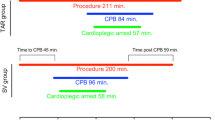Abstract
Background
Stroke is the worst feared complication of Coronary Artery Bypass Graft Surgery (CABG). Anaortic approach using arterial conduits is the best method to reduce the stroke incidence. An alternative approach using saphenous vein conduit is described here.
Methods
Thirty-six patients with a high risk of developing perioperative stroke underwent coronary artery bypass surgery by this anaortic method utilizing Left Internal mammary artery and saphenous vein conduits in a “Composite Y” fashion during the period from 2009 to 2012. The follow-up is 100 %. The median follow-up of these patients is 285 days.
Results
There was no operative mortality. No patient developed perioperative stroke. Two patients developed stroke more than 1 year after the operation.
Conclusions
Left Internal Mammary Artery (LIMA) and saphenous vein conduits in a “Composite Y” fashion is a good alternative anaortic approach when the standard arterial conduits are not available both in the short-term and medium-term follow-up.

Similar content being viewed by others
References
Lev-Ran O, Braunstein R, Sharony R, et al. No touch aorta off-pump coronary surgery: the effect on stroke. J Thorac Cardiovasc Surg. 2005;129:307–13.
Halbersma WB, Arrigoni SC, Mecozzi G, et al. Four year outcome of OPCAB no-touch with total arterial Y-graft: making the best treatment a daily practice. Ann Thorac Surg. 2009;88:796–801.
Serruys PW, Morice MC, Kappetein AP, et al. Percutaneous coronary intervention versus coronary artery bypass grafting for severe coronary artery disease. N Engl J Med. 2009;360:961–72.
Kapetanakis EI, Stamou SC, Dullum MKC, et al. The impact of aortic manipulation on neurologic outcomes after coronary artery bypass surgery: a risk adjusted study. Ann Thorac Surg. 2004;78:1564–71.
Emmert MY, Seifert B, Wilhelm M, Grunenfelder J, Falk V, Salzberg SP. Aortic no-touch technique makes the difference in off-pump coronary artery bypass grafting. J Thorac Cardiovasc Surg. 2011;142:1499–506.
Cirillo M, Messina A, Tomba MD, et al. A new no-touch aorta technique for artetial source, off-pump coronary surgery. Ann Thorac Surg. 2009;88:e46–7.
Agostini M. A new no-touch aorta technique. Ann Thorac Surg. 2010;90:359–60.
Herz I, Mohr R, Aviram J, et al. The right internal thoracic artery and right gastroepiploic artery: alternative sites for proximal anastamosis in patients with atherosclerotic calcified aorta. Heart Surg Forum. 2004;7:E481–4.
Gusic RJ, Myung R, Petko M, Gaynor JW, Gooch KJ. Shear stress and pressure modulate saphenous vein remodeling ex vivo. J Biomech. 2005;38:1760–9.
Conflict of interest
None
Author information
Authors and Affiliations
Corresponding author
Rights and permissions
About this article
Cite this article
Raghuram, A., Krishnan, R., Kumar, S. et al. An alternative anaortic approach. Indian J Thorac Cardiovasc Surg 29, 89–92 (2013). https://doi.org/10.1007/s12055-013-0206-4
Received:
Revised:
Accepted:
Published:
Issue Date:
DOI: https://doi.org/10.1007/s12055-013-0206-4



